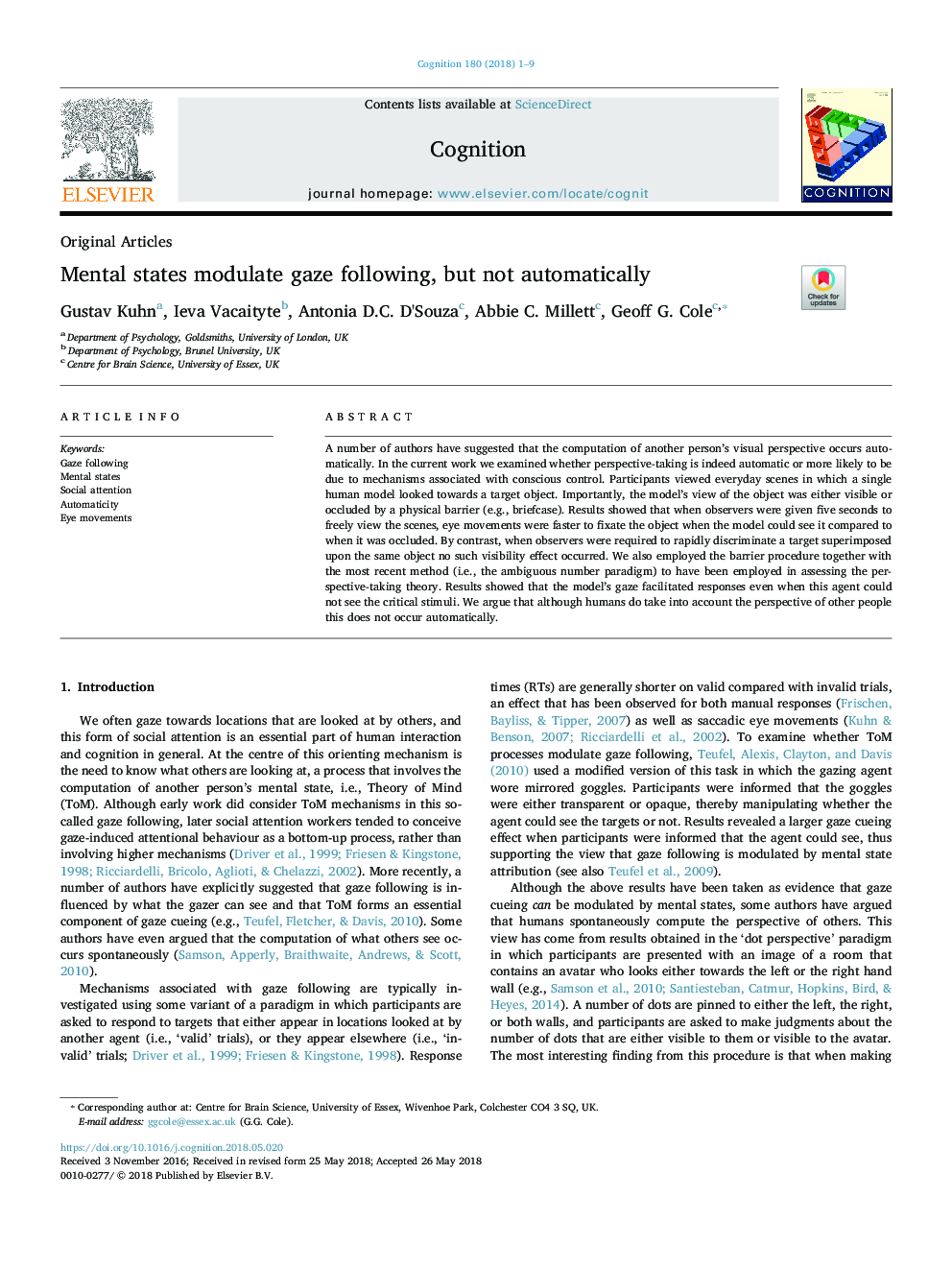| کد مقاله | کد نشریه | سال انتشار | مقاله انگلیسی | نسخه تمام متن |
|---|---|---|---|---|
| 7285020 | 1474087 | 2018 | 9 صفحه PDF | دانلود رایگان |
عنوان انگلیسی مقاله ISI
Mental states modulate gaze following, but not automatically
ترجمه فارسی عنوان
حالتهای ذهنی ذهن را به دنبال دارد، اما نه به طور خودکار
دانلود مقاله + سفارش ترجمه
دانلود مقاله ISI انگلیسی
رایگان برای ایرانیان
کلمات کلیدی
نگاه کردن به دنبال، دولتهای روحانی، توجه اجتماعی، خودکار حرکات چشم،
ترجمه چکیده
تعدادی از نویسندگان پیشنهاد کرده اند که محاسبه چشم انداز بصری فرد دیگری به صورت خودکار صورت می گیرد. در کار فعلی ما مورد بررسی قرار گرفتیم که آیا دیدگاه در واقع خودکار است یا بیشتر به دلیل مکانیسم های مرتبط با کنترل آگاهانه است. شرکت کنندگان صحنه های روزمره را مشاهده کردند که در آن یک مدل انسانی به سمت یک هدف هدف نگاه می کرد. مهمتر از همه، دیدگاه مدل از این شیء، قابل مشاهده است یا توسط یک مانع فیزیکی (از جمله کیف) است. نتایج نشان داد که وقتی ناظران پنج ثانیه برای مشاهده صحنه ها آزاد شدند، حرکات چشم سریعتر شد تا جسم را هنگامی که مدل می تواند آن را در مقایسه با زمانی که آن را بسته بود مقایسه کند. در مقابل، هنگامی که ناظران مجبور شدند به سرعت هدف مورد نظر بر روی همان شیء را تبعیض نکنند، چنین تأثیر دیدی رخ نخواهد داد. ما همچنین روش مانع را با آخرین روش (یعنی پارادایم عدد مبهم) که در ارزیابی نظریه چشم انداز استفاده شده است استفاده می کنیم. نتایج نشان داد که دیدگاه این مدل پاسخ ها را آسان می کند حتی زمانی که این عامل نمی تواند محرک های بحرانی را ببیند. ما استدلال می کنیم که اگرچه انسان به دیدگاه دیگران توجه می کند، این به طور خودکار رخ نمی دهد.
موضوعات مرتبط
علوم زیستی و بیوفناوری
علم عصب شناسی
علوم اعصاب شناختی
چکیده انگلیسی
A number of authors have suggested that the computation of another person's visual perspective occurs automatically. In the current work we examined whether perspective-taking is indeed automatic or more likely to be due to mechanisms associated with conscious control. Participants viewed everyday scenes in which a single human model looked towards a target object. Importantly, the model's view of the object was either visible or occluded by a physical barrier (e.g., briefcase). Results showed that when observers were given five seconds to freely view the scenes, eye movements were faster to fixate the object when the model could see it compared to when it was occluded. By contrast, when observers were required to rapidly discriminate a target superimposed upon the same object no such visibility effect occurred. We also employed the barrier procedure together with the most recent method (i.e., the ambiguous number paradigm) to have been employed in assessing the perspective-taking theory. Results showed that the model's gaze facilitated responses even when this agent could not see the critical stimuli. We argue that although humans do take into account the perspective of other people this does not occur automatically.
ناشر
Database: Elsevier - ScienceDirect (ساینس دایرکت)
Journal: Cognition - Volume 180, November 2018, Pages 1-9
Journal: Cognition - Volume 180, November 2018, Pages 1-9
نویسندگان
Gustav Kuhn, Ieva Vacaityte, Antonia D.C. D'Souza, Abbie C. Millett, Geoff G. Cole,
